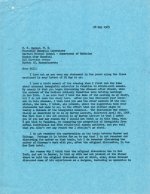|
Pauling first heard of sickle cell anemia in 1945 from Dr. William B. Castle of Harvard Medical School and Boston City Hospital. In the mid-1940s, Pauling and
Castle were on a Medical Advisory Committee together that compiled a report for Vannevar
Bush's influential Science: The Endless Frontier, which outlined post-war funding for medical research. All of the Palmer Committee
members, excluding Pauling, were physicians. During 1945 Castle talked about sickle
cell anemia to some committee members and mentioned that the red blood cells of sickle
cell anemia patients change from a normal shape in the arterial blood to a crescent
shape in the venous blood.
Upon hearing this, Pauling immediately jumped to some conclusions that were based
on the various scientific works that he had conducted in the previous decade. In particular
he drew from his intimate knowledge of immunology and of hemoglobin and its derivatives:
oxyhemoglobin and carbonmonoxyhemoglobin. Two important ideas dawned on Pauling that
he and his colleagues followed up on. First, based upon the information that only
deoxygenated blood sickles, he concluded that hemoglobin was involved. Secondly, he
suggested that the structure of sickle cell hemoglobin might differ from that of normal
hemoglobin and that the structural difference caused deoxygenated sickle cell hemoglobin
to bond to itself and convert the red blood cells into a crescent shape.
Pauling immediately wanted to follow-up on his intuition and asked Castle if he could
try some experiments, to which Castle agreed. Pauling also spoke with another member
of the committee, Dr. Ed Doisy of St. Louis University Medical School, who suggested
that Pauling admit his recently graduated medical student, Harvey A. Itano, to the Ph.D. program in chemistry at Caltech. Itano arrived at Caltech in September
1946 to work on this project.
|
|
Click images to enlarge

Sam Morall and Linus Pauling, prior to a joint presentation made by Pauling and William
B. Castle, Milwaukee, Wisconsin. June 2, 1969.

Letter from Linus Pauling to William Castle. May 28, 1963.
"I remember asking a new graduate student, Harvey Itano, what his research problem
was. He said he was going to test your hunch that there was a difference in hemoglobin
molecules between normal people and those with sickle cell anemia. I thought that
was a crazy idea; a complicated human disease could not have any such simple cause.
And so I learned to respect bold simple ideas -- especially those conceived by Linus
Pauling."
|

